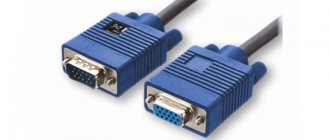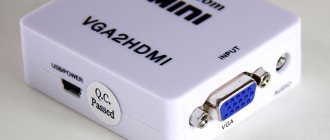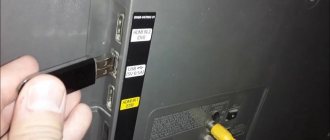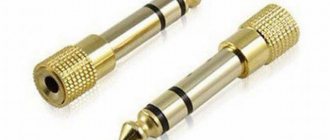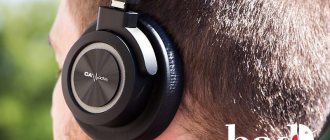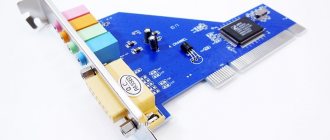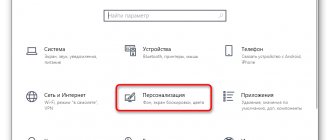What is the difference and what are the benefits of Hi-End players?
The dream that someday engineering will merge together and a single universal port will come to the world, which will be devoid of shortcomings and will be suitable for any purpose in any industry, remains a dream. Optical, coaxial, jack, S/PDIF... This variety makes your head spin. Today we will look at the main audio ports that are used in portable gadgets. Three premium brands that produce Hi-End players will help us with this: Astell&Kern , Colorfly and HiFiMan .
HDMI (High-Definition Multimedia Interface)
Used for: connecting Blu-ray players, TVs, AV receivers, game consoles, personal computers and other high-frequency video devices. If you have a choice, choose this over an analog audio cable and a component video cable. This is similar to the performance and usage of the DVI digital video interface. Is an adapter for: DVI, Mini-DVI, Micro-DVI. Additional ports: connection to the receiver. In addition to carrying pure HD video at resolutions of 1080 pixels or more, HDMI can carry surround sound, including DTS and Dolby Digital. This digital cable fits most home theater slots, including TVs, receivers and game consoles. It supports HDCP encryption, so you can play copy-protected movies without any problems. This type of connection comes in several versions: standard HDMI 1.3 cable or high-speed 1.4 cable. The new version has additional bandwidth for viewing high-definition 3D video.
Troubleshooting
The simplest steps can resolve the problem of headphones not working. This works 95% of the time. The elimination algorithm is as follows:
- Check that the plugs are installed in the correct ports.
- Remove them from the connectors and connect them again.
- Restart your PC. This action will eliminate the factor of a random system error, due to which the sound could disappear.
- If the laptop does not see the headphones, open the official website of the headphone manufacturer and find the “Support” section. Using the model name, pull up a link to the driver for your headset to work. Download and install the drivers via an executable exe file or using the device manager, through the driver update item by headphone name in the “Audio inputs and audio outputs” section.
- When the laptop stops seeing the wireless headphone, check if Bluetooth is working. Plus, make sure that everything is in order with the drivers (they are at least present) and the adapter is working (the other devices are paired as normal).
- Wireless headphones run on batteries. The possibility of battery discharge and concomitant loss of sound should be taken into account. Make sure there is enough charge and restart the device itself.
Damage to parts when headphones from a laptop do not work cannot be ruled out either. For example:
- Plug failure. If this damage occurs, the headphones will not transmit signals and both speakers will not work. If you are comfortable with a soldering iron, it is recommended to purchase a plug and solder it to the wires. Otherwise, contact the service center for qualified assistance in this matter.
- One of the contacts is damaged. Typically, this breakdown fits into the area where it interfaces with the plug. In this case, the sound is present in one or two headphones, but the quality of the audible sound is a multiple of times worse than it should be (the sound may be quiet or noisy). When you touch the wire with your fingers where the plug begins, and the sound begins to deteriorate/improve, it is almost certainly the contacts that are to blame.
- If the laptop's video card stops working, it is recommended to take it to a service center. The damaged component is replaced with a working one.
- The connector on the laptop is broken. In this case, it is recommended to replace the connector, which can easily be done at a service center.
Drivers are a bridge between the software and hardware parts of devices. It is recommended to check its presence and install it if it is damaged or missing.
RCA (also known as composite video or phono plug)
Used for: basic settings, analog audio and video, sometimes digital audio. If you have a choice, choose this over coaxial cable. Is an adapter for: TRS “mini jack” (found on video cameras or MP3 players). RCA is introduced as a connector used throughout home audio and video equipment. For basic settings, you can use the white plug, as well as for mono audio or left channel, the yellow plug for video. The red plug usually means right-channel audio, but the connector can also carry other signals. Sometimes used in digital audio, in which a single cable carries the full surround audio signal. This cable is also suitable for component video.
How to connect wireless bluetooth headphones to a laptop - instructions + video
Brief instructions using the example of an Asus laptop (Windows 10) and JBL headphones:
- Turn on Bluetooth on the laptop (if not turned on)
- We turn on the headphones + search mode for accessibility for detection (pressing the button on or separate).
- Open Bluetooth device management in the laptop.
- We add (look for) a new device.
- From the list that appears, select your headphones and connect.
Enable Bluetooth on a laptop (Windows 10):
JBL headphones connected to a Windows 10 laptop:
Component video (also called RGB or Y-Pb-Pr)
Used for: HDTV video (especially on older TVs) and gaming systems. If you have a choice, choose it over composite RCA video, S-Video. This is similar to the performance and usage of a VGA cable (especially the RGB version). Is an adapter for: VGA if the device uses the RGB version. Additional ports: splitter, repeater or receiver. Component video signals are transmitted through three RCA cables, typically red, green, and blue. Component video operates at speeds up to 1800i, making it optimal for analog HDTV connections. Cables are usually designated Y/Pb/Pr, and indicate the level of brightness, blueness and redness. Some systems use different designations, often RGB meaning red, green and blue. There are devices that support both, but if you end up with an image that's completely green-toned, you've likely created the wrong color space.
S-Video (or Y/C)
Is used for: . If you have a choice, choose this over composite RGA and coaxial cable. It is an adapter for: composite video (but with loss of quality benefits). Additional ports: splitter, repeater or radio receiver. Although this type of connection expands on the composite RCA connection, S-Video still cannot be on par with cables that support HDTV.
Coaxial video (cable TV connection)
Used for: connecting antennas, conducting VRC for analog TV, connecting a cable broadcast source and a TV. This is analogous to the performance and use of composite video. Additional ports: splitter connections. Coaxial cable is used to transmit video and audio signals between devices. The cable is also suitable for a TV tuner antenna. Most cable companies use this type of conductor, although they primarily send a digital signal that is converted and decoded on your TV. You can almost always run a coaxial cable to your TV (with the exception of connecting a digital antenna), but you should expect only the basic quality features to work correctly.
Toslink (also known as optical cable or S/PDIF)
Used for: gaming systems, connecting DVD players, cable boxes, and other radio devices. If you have a choice, choose this over analog RCA audio and other audio cables. This is similar to the performance and use of a single analog RCA audio cable. Is an adapter for: Mini Toslink. Additional ports: splitter and receiver. In digital connections, Toslink sends optical pulses that are decoded into audio. Typically an S/PDIF signal is used to provide surround sound details. (“S/PDIF” is sometimes used as a synonym for optical cable, although Toslink refers more to physical connectors). Mini-Toslink cables are sometimes used, especially with Apple computers, such connectors are often inside a standard 3.5mm stereo mini-jack port. The smart home system also uses such a cable in its connections.
Mini-jack (TRS, 3.5mm jack, 1/8 inch jack, headphone jack)
Used for: portable audio devices, computers, portable speakers, video cameras. This is similar to the performance and use of a 1/4 inch jack, a 2.5mm jack. Is an adapter for: 2.5mm jack, RCA jack, 1/4 inch jack. This headphone jack is found in almost all audio devices, and is offered as the main jack on media players. You'll most often encounter stereo connections that have two rings on the end of the plug. If the plug has only one ring, then it will only conduct mono audio. The connector is also often used to carry video along with audio, converting a mini-jack to an RCA device. The audio signal on the minijack is louder than the stereo RCA signal, so if you are using an adapter (for example, connecting an iPod to the receiver), then increase the volume gradually.
1/4 inch connector (TRS)
Used for: music equipment, headphones, professional equipment, home theater audio equipment. If you have a choice, choose this over a mono mini-jack. This is similar to the performance and use of a mini-jack, 2.5mm jack. Is an adapter for: mini-jack, 2.5mm jack, RCA jack. Additional ports: splitter connection. This jack most often carries stereo sound through headphones. It is also used on professional audio equipment, home theater audio components, and many other headphone-equipped devices.
How to turn on headphones on a computer or laptop using standard methods in windows, linux, macos
You can set up the headset on any device, be it a modern laptop from Asus or a huge server computer running Linux. For a system running under Windows, the instructions will be short.
- Connect the headset through the connector on the front panel (we'll talk about this later) or through the round green connector on the back of the PC. If we are talking about a laptop, use a small round socket.
- Click on the small speaker icon in the control panel called the mixer.
- Click on the icon under the volume control if it is crossed out.
For Linux users, the instructions will be similar. Fans of a professional operating system also have a mixer, although it is a little more complicated. But all you have to do is pull the control and set the volume to medium or high.
2.5mm jack (also known as TRS)
Used for: mobile phone headset. If you have a choice, choose this instead of a mini-jack, a 1/4-inch jack. Is an adapter for: RCA connector, 1/4 inch connector, mini-jack. Additional ports: splitter. Although most mobile phones have a mini-jack connector, there are also many interfaces with a 2.5mm jack that support microphones or button locking. However, you can connect a fairly large headphone cable to this small jack and listen to music.
Used for: mid to high end microphones. If you have a choice, choose this over the 1/4 inch connector. This is similar to the performance and use of a 1/4 inch jack. Is an adapter for: 1/4 inch jack (but this will not amplify the microphone). Additional ports: connection to a mixer. Although this connector can support a large number of pins, the three-pin version is most often used in midrange and professional audio equipment. Microphones also often use an XLR cable to amplify the sound.
Used for: connecting speakers. Additional ports: receiver or splitter connections. A twisted wire (each containing two cables inside) connecting the speakers to the receiver. The caliber of the speaker cable is of great importance if it needs to be stretched over long distances. Thicker, lower gauge wires work best. Try to select the cable length so that there is no excess left, otherwise there will be interference in signal transmission. You can use a banana plug to connect the cables, but you will achieve the same results by simply connecting the bare wires.
Audio connectors for laptops,
used to connect audio devices, there are several types.
Audio connectors
1. TRS connector
. Alternative names: Balanced Jack, balanced jack, stereo jack, or simply jack. (nest translated from English). Stands for "Tip", "Ring" and "Sleeve" ("tip", "ring" and "sleeve"), which indicate the corresponding parts of the connector. As a rule, they are used for instrument and console switching, as well as for connecting headphones. Jacks are divided into several subspecies. They all have different connector diameters.
1.1. Jack/jack. Connector with a diameter of 1/4 inch or 6.35 mm.
Used in pop microphones, as well as for karaoke or home recording, connecting electric guitars, bass guitars, amplifiers, professional headphones, as well as professional-level sound cards;
1.
2
Mini-jack/mini-jack.
Connector with a diameter of 3.5 mm . It is used in ordinary headphones for a telephone or player, in a computer speaker system, headset, player, consumer-level sound card. This jack is the most common headphone size and is widely used in most portable and mobile devices;
1.3. M
ikro-jack/micro-jack. A connector with a diameter of 2.5 mm is found in wired mobile phone headsets. However, with the beginning of the smartphone era, this type of connector is used much less frequently than the mini-jack.
XLR connector
. Alternative name "Cannon". There are two types of connectors - “male” and “female”.
connector
. Alternative
name: tulip or bell. It belongs to professional connectors, but it is often used on sound reproduction devices and DJ equipment.
In order to connect speakers or headphones to the audio jacks and enjoy watching your favorite movies or listening to music, you need to insert the speaker/headphone cable into the audio jacks for laptops.
As a rule, laptops have only two connectors: for speakers and for speakers.
Often, audio connectors for laptops
are located on the front or side panel of the laptop and are not difficult to find.
Depending on the speaker model, they also have either a power cord that needs to be connected to an outlet or a USB cable. Portable speaker models have become popular recently. Both sound transmission and power supply occur only through a USB cable. They are very light, compact and ideal for people who spend a lot of time on the road.
Many modern laptops are equipped with only one headset jack: either for headphones, but without a microphone, or for a headset. In order to understand and not damage the audio connectors for laptops
You need to carefully study the instructions and find out which devices can be connected and which cannot. There are headsets equipped with a USB port, then everything is simple, connect it via a USB connector and enjoy the work. If you have a regular headset with two connectors (both for headphones and a microphone), then you need an adapter from 3.5 mm to a connector designed for a combined headset. Or you can purchase a special headset with a combo and one 3.5 mm jack.
There are a great variety of connectors for connecting audio equipment. In this article we will look at the main connectors that are used for audio switching. However, you can use any connector, even a bare wire, as long as it provides reliable contact.
1. Banana connector
Banana connectors are a connector for connecting acoustics, measuring equipment probes or laboratory power supplies. The contact terminal of the plug is made of spring-loaded plates to ensure tight contact with the socket. The contact diameter of the plug can be 2 mm or 4 mm. A protective casing is used as insulation. The plug housing has a collapsible design and is designed for installation on a cable.
2. XLR connector
XLR connectors come in male, female, and male connectors. Use a balanced connection. They are mainly used in professional audio, video and lighting equipment. The connector is colloquially called Canon. XLR connectors are used for symmetrical signal transmission. Their use is mainly justified if the signal transmission has a long distance. They simply cannot be connected to an amplifier, since the amplifier itself must have such connectors, and therefore the corresponding circuit.
3. TRS connector (jack)
This connector was developed in the 19th century for use in telephone switches and had a different shape from modern plugs. Usually it has three contacts (TRS, stereo), but there is an option with two (TS, mono), four (TRRS), and rarely five contacts (TRRRS).
There are three standard connector diameters:
- jack (6.35 mm, 1/4 inch); mini-jack (3.5 mm); micro-jack (2.5 mm).
Often 1/4″ TS is called “jack” or “quarter-inch jack”; The 3.5 mm TRS connector is called a “mini jack”; TRRS 2.5 mm connector - micro-jack.
4. Speakon connector
This type of cable connector, developed by Neutrik and is a registered trademark of Neutrik AG, is used primarily in professional audio systems for connecting speaker systems to power amplifiers.
Connecting speaker cables are usually equipped with Speakon male connectors on both sides. Amplifiers and speaker systems have female connectors. In addition, there are connectors for two cables, made in the form of two female connectors in a small plastic tube. Speaker systems often have two female connectors installed - a primary and a secondary, which are intended for connecting additional speaker systems or subwoofers to the same channel. Speakon connectors are designed for high currents (up to 40 A). They provide protection from human contact with live parts, which is important for powerful amplifiers.
Speakon connectors can contain two, four or eight pins. Two- and four-pin connectors are partially compatible with each other, eight-pin connectors are larger. The most common are four-pin connectors; they allow the use of separate amplifiers for the low-frequency and high-frequency paths without the use of additional cables and connectors.
5. RCA connector (tolpan)
RCA jack or colloquially “tulip”, “bell”, AV connector. The name RCA comes from the Radio Corporation of America, which introduced this type of connector in the early 1940s for connecting phonographs to amplifiers.
The big disadvantage of such connectors is that when connecting, the signal contact pair (with voltage) is connected first, and only then the housing contacts. This can cause damage to the devices at the time of connection if there is a potential difference between the housings.
A standard RCA plug (slang for “male”) looks like a central metal protruding pin surrounded by a metal round rim. The outer diameter of the rim depends only on its thickness and is not standardized. The RCA jack is usually a panel connector (slang for "female") that the headband fits onto, so the headband's crimping jaws must have a slightly larger internal diameter.
In inexpensive versions, the space between the connector/collet and the rim/housing (internal insulator) is filled with simple plastic or polyethylene, in mid-price ones - with textolite washers or similar ones made of pressed fiberglass, in expensive ones - with heat-resistant Teflon or ceramics.
6. Spade type connector
The spade type connector is used to connect speaker cables of various cross-sections. The cable can be brought in at different angles. The cable is clamped with screws. This type of connector allows for good contact and maximum commutation area in the connector, which in turn securely locks the blade in place with a screw clamp.
7. DIN 41529 for loudspeakers (dot-dash connector)
A polarized, two-pin, unshielded connector designed to connect a loudspeaker to an audio power amplifier. Known as DIN 41529 loudspeaker connector. It comes in panel-mounted receptacle and wire-mounted receptacle/plug versions. The plug has a flat center contact and an off-center round contact. The round contact must be connected to the positive pole (red), and the flat contact to the negative pole (black).
Soviet analogues: ONTs-VN-1-2/16-V - plug and ONTs-VN-1-2/16-R - socket. In the Soviet Union even now, it is unofficially called the “dot-dash connector.”
This connector can currently be found mainly on older equipment. The same connector is used to connect some halogen lamps to a power source, as well as in Soviet Hi-Fi amplifiers and German vintage acoustics and amplifiers/receivers. There are also three- and four-pin versions of this connector, used, for example, by Bang & Olufsen.
8. Toslink (connector for digital signal transmission)
Toslink is a fiber optic connection standard developed by Toshiba Corporation. Often used in household audio equipment, computer sound cards, where a digital audio stream is transmitted. Toslink was originally developed by Toshiba for transmitting PCM audio streams between branded CD players and AV receivers, but was soon adapted for most CD players, regardless of manufacturer.
9. DIN connector
A connector originally standardized by the German Institute for Standardization. There are DIN standards for many types of connectors, so the term "DIN connector" does not mean any specific type of connector unless the standard number is specified (for example, "DIN 41524 connector").
In the context of consumer electronics, the term "DIN connector" usually refers to the family of circular connectors originally standardized by DIN for analog audio signals. Some of these connectors were later used for analog video and for digital interfaces such as MIDI or the PS/2 connector for a personal computer keyboard and mouse. The original DIN standards for these connectors are no longer in print. They have been superseded by the equivalent international standard IEC 60130-9.
Although DIN connectors appear similar in appearance to the new professional XLR connectors, they are not compatible. There are seven common layouts with a number of pins ranging from three to eight.
Quality cables retain the dynamic, accurate sound of the original recording. Even good cables cannot improve or expand the sound quality that is recorded on the disc. But low-quality cables can actually limit the frequency, causing the sound to be flat and not lively. Therefore, when buying audio cables, the following will suit you:
Cables whose center conductor is made of oxygen-free copper (OFC) as they almost guarantee no signal loss.
- The best shielding you can find are cables that include two separate shields - one of braided copper for RFI protection, and one of foil for EMI protection. This will help protect the signal from noise and pollution.
- Good connectors that ensure constant high pressure contact with the receiver sockets. If the cables you choose have metal plugs, it's worth paying attention to the presence of gold plating to prevent corrosion and reliably support a high-quality signal.
1.1. Connecting Bluetooth headphones to a laptop
detailed instructions
There is a slight difference in how to connect Bluetooth headphones to a laptop on Windows 7 and 10. First, we consider the example with the “ten” (we connect JBL headphones to the Asus laptop), and then with the “seven”.
- Bluetooth is turned on by a keyboard shortcut or in the tray around the clock . The button combinations vary depending on the specific laptop model, but the essence is the same: the “Fn” key + one of the F-buttons, on which, in addition to the number, there is a Bluetooth icon. After this, we check whether the function is activated in the same tray. 1.1 In Windows 10, click on the side menu button (to the right of the clock) and look for the Bluetooth block at the bottom of this menu. You may need to click Expand. Found - click, we see activation.1.2 In Windows 7, the Bluetooth icon is located in the general tray to the left of the clock. You may need to press the "^" button to show hidden items. Accordingly, we activate the function there.
- How to enable search mode on headphones is described in detail in our corresponding instructions.
- Find the Bluetooth icon in the tray, right click – add device.
- Next, there is a difference in connecting wireless headphones on Windows 10 and 7. 4.1 Windows 10 . The add devices panel opens. Select “Add Bluetooth or other device.” In the window that opens, select Bluetooth again (first item). A list of available devices will open. In rare cases, you may need to enter a code. Default: 0000 or 1111. You can look in the instructions for the headphones. 4.2 Windows 7 .
The search window immediately opens, wait and select your headphones. In rare cases, you may need to enter a code. Default: 0000 or 1111. You can look in the instructions for the headphones. This is also true for the “ten”. Maybe. I haven't seen anything like this before.

